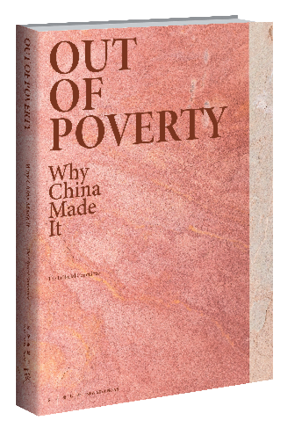
Out Of Poverty: Why China Made It
Authors: Weng Tiehui and Members of the Editorial Committee
Price: RMB 129
Paperback, 337 pages
Published by New Star Press
China is home to nearly one fifth of the world’s population. Its eradication of extreme poverty has significantly reduced the size of the world’s poor population and made a significant contribution to global poverty alleviation. The tremendous achievements, especially in the rural areas in China’s central and western regions, have boosted the world’s confidence in eradicating extreme poverty and achieving the United Nations Sustainable Development Goals.
Out Of Poverty: Why China Made It explains the historical process, achievements, experience and significance of China’s poverty alleviation efforts in four parts.
Part One, “China’s Victory over Poverty: Perspectives,” provides the historical context of China’s journey out of poverty. The Communist Party of China (CPC), founded in July 1921, made rejuvenation of the Chinese nation and ensuring a better life for the people its aspiration and mission, and united and led them in the long and arduous journey towards a better life. During the century-long fight against poverty, the Party formulated newer forward-looking strategies. They included the “three-step strategic plan” to ensure adequate food and clothing for all as the first step, a moderately prosperous life as the second step, and a relatively affluent life as the third step. Common prosperity was the ultimate goal, and building a moderately prosperous society in all respects a milestone on the way.
Since the 18th CPC National Congress in 2012, the decisive battle against poverty was unprecedented in scale and intensity, benefiting the largest number of people in human history. Today, China’s once impoverished areas have been transformed with improved living standards and working conditions as well as better local public services systems. These changes plus the enhanced awareness among the people and significantly improved governance capacity at the grassroot level have laid a solid foundation for the success of the efforts to achieve modernization in all respects.
Part Two, “China’s Victory over Poverty: Approaches,” concludes that the CPC’s significant achievements in poverty alleviation were due to its political and organizational strengths, the targeted poverty alleviation strategy it implemented, and pooling strength from the entire society.
Poverty alleviation was made the priority of the Party committees and governments at all levels in poverty-stricken areas, motivating Party members and officials to take initiatives. At the Second Plenary Session of the 12th National People’s Congress in 2014, President Xi Jinping directed that “inspection tours must be conducted to identify the truly poor. Poverty alleviation must reach those who truly need it, and poverty must be fully eliminated.” His words guided the Party members to carry out targeted poverty alleviation, which later evolved into specific instructions including identifying the poor precisely, adopting targeted measures tailored to different groups, and ensuring people remained above the poverty line. The entire Chinese society was mobilized to participate in poverty alleviation, and there were special measures like the developed eastern provinces being paired with the underdeveloped western ones to help them grow their economy.
Part Three, “China’s Victory over Poverty: Enabling Conditions,” discusses several questions: What is poverty? How does it occur? How can it be eradicated? Marxism identifies the economic, political and social causes of poverty and the prerequisites for poverty eradication based on historical materialism and a people-centered approach. The CPC followed Marxist theories and approaches based on China’s specific conditions and was thus able to create an unprecedented miracle in its poverty alleviation efforts.
Low productivity and slow economic growth are major causes of poverty, but productivity growth can’t automatically reduce poverty. Poverty is also closely linked to the governance system of a country. The CPC therefore established political, economic and cultural structures to marshal resources for poverty alleviation. This is the secret of China’s victory over extreme poverty.
Part Four, “China’s Victory over Poverty: International Implications,” puts China’s fight against poverty in a global context, indicating what China’s achievements mean to the world and the experience to be gained from them. All countries have been making persistent efforts to explore suitable paths and solutions for poverty eradication, and these provided useful references for China’s elimination of poverty. China’s success is inseparable from the support and assistance of the international community. China too fulfilled its international responsibilities by engaging in international cooperation in poverty reduction while committed to poverty reduction at home. It has been providing assistance to developing countries within its capacity, promoting global poverty reduction.
The eradication of extreme poverty in China is epoch-changing, and significant theoretically, practically and globally. Out Of Poverty: Why China Made It combines storytelling with comments and viewpoints validated by case studies based on official data.